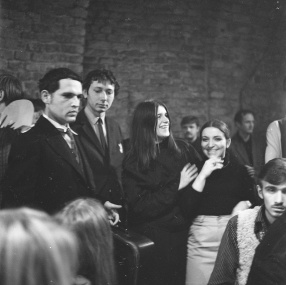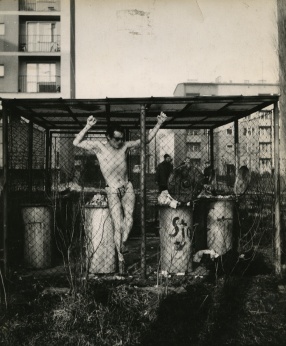KRZYSZTOF NIEMCZYK
Cracow 1966-1970.
He was discovered „for the Avant-guard” by Maria Stangret-Kantor. Krzysztof Niemczyk was walking along the streets of Cracow with wings of a poet on his arms, took bath in a fountain at the Mariacki Church, rolled a bid head of cheese out of a state shop within the frame of a spectacular theft action entitled „Dziubara”(„The Stealing”).
Author of public scandals, a legendary figure of 1960-s, he was immediately accepted in the Kantor’s circle in Cracow and Foksal Gallery circle in Warsaw as „the most true from the true”, an artist and the most promising writer, inheritor of pre-war literature Avant-guard, which he has not felt to be at all. He had no sense of belonging whatsoever to its traditions or present (…).
The notion of „Social Avant-guard” did not exist for him either, although he was on its farthest gable in some sense. He would be surprised and amused, if someone would say to him that he impersonates a heroic model of a „cursed artist”, or that his life is an individual revolution. He mocked at the hippies movement and treated them as the audience for his own performances, or individually – as friends. His spontaneous and expressive painting, mainly portraits, was totally „out-of-date”. In advance of twenty years Niemczyk practices „neo-barocco” and „new figuration” in 1960-s. However, these terms, as well as eventual precursory, had no content for him. Painting, as well as literature, music, private and public behavior were natural emanations of his internal and fully natural impulses. Still, the circle of artistic Avant-guard was the only social area, capable of receiving and accepting him. Hence his tragic and definitive dimension of this section of Krzysztof Niemczyk’s life.
(…) Niemczyk entered the circle and started to seed his dangerous appeals on varnishing days, Cricot dramatics, in „Krzysztofory” coffee shop and in Foksal. People remember his participation in the Ball in Zalesie. In a topper-hat enlaced with jasmine, he furiously played Tchaikovsky’s concert at five a.m.; he was also a character of the scene „Under the Jasmine Bush”, which the critics prefer to conceal and which was memorialized by the Krzysztof’s portrait made in early morning by Eustachy Kossakowski. Two days later he asked for an audience in this dressing from the Minister of Culture and Art. He was vigorously expelled, so he proudly walked away along the central street Krakowskie Przedmieście – in a topper-hat and ball jasmine.
[Anka Ptaszkowska, Krzysztof Niemczyk and Foksal, 2007 [in:] Anka Ptaszkowska, I believe in freedom, but my name is not Beethoven. Gdańsk 2010]


